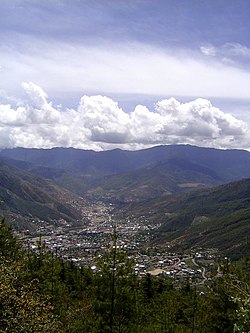Thimphu District
Thimphu Dzongkhag
ཐིམ་ཕུ་རྫོང་ཁག | |
|---|---|
 Thimphu district | |
 | |
| Country | Bhutan |
| Headquarters | Thimphu |
| Area | |
• Total | 2,067 km2 (798 sq mi) |
| Population (2017) | |
• Total | 138,736 |
| • Rank | 1st |
| • Density | 67/km2 (170/sq mi) |
| Time zone | UTC+6 (BTT) |
| HDI (2021) | 0.832[1] very high · 1st |
| Website | www |
27°35′N 89°35′E / 27.583°N 89.583°E
Thimphu District (Dzongkha: ཐིམ་ཕུ་རྫོང་ཁག་; Wylie: Thim-phu rdzong-khag) is a dzongkhag (district) of Bhutan. Thimphu is also the capital of Bhutan and the largest city in the whole kingdom.
Languages
[edit]The dominant language throughout the district is Dzongkha; however, within the capital nearly every language of Bhutan may be encountered.[2]
Administrative divisions
[edit]Thimphu District is divided into eight gewogs and one town (Thimphu):[3]

Lingzhi, Soe and Naro Gewogs belong to the Lingzhi Dungkhag subdistrict, the only subdistrict within Thimphu District. The remaining gewogs do not belong to any subdistrict.[4]
Town of Thimphu
[edit]Thimphu is the capital of Bhutan and Thimphu district.
Environment
[edit]The northern half of Thimphu District (the gewogs of Kawang, Lingzhi, Naro and Soe – corresponding roughly to Lingzhi Dungkhag) is subject to environmental protection, falling within Jigme Dorji National Park.[5]
- Thimphu District
-
View of Thimphu
-
Rice terraces
-
Traditional house
-
108 Choerten on the Dochu La
-
View from Dochu La
See also
[edit]References
[edit]- ^ "Sub-national HDI - Area Database - Global Data Lab". hdi.globaldatalab.org. Retrieved 2018-09-13.
- ^ van Driem, George L. (1993). "Language Policy in Bhutan" (PDF). London: SOAS. Retrieved 2011-01-18.
- ^ "Chiwogs in Thimphu" (PDF). Election Commission, Government of Bhutan. 2011. Retrieved 2011-07-28.
- ^ "Lingzhi Geog". Thimphu Dzongkhag Administration. Archived from the original on September 6, 2009.
- ^ "Parks of Bhutan". Bhutan Trust Fund for Environmental Conservation online. Bhutan Trust Fund. Archived from the original on 2011-07-02. Retrieved 2011-03-26.
External links
[edit]





